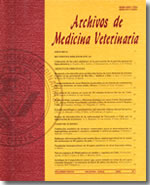Relationship between β-hydroxybutyrate and the fat: protein ratio of milk during early lactation in dairy cows
Main Article Content
Abstract
During early lactation in dairy cows, a negative energy balance compels the cow to use body fat and proteins to meet its milk producing requirements increasing the availability of free fatty acid, resulting in an increased milk fat synthesis by the udder. At the same time, these changes in energy balance may cause an insufficient protein synthesis by ruminal bacteria, compromising the flow of amino acids to the udder and decreasing the milk protein content. Since herd milk components are routinely analysed, the aim of this study was to use the data of the fat:protein ratio of milk routinely gathered at farms to estimate the serum concentrations of β-hydroxybutyrate, and as predictor of subclinical ketosis in dairy herds at early lactation. Data from 59 samples, one per herd (average of 5 individual samples each) of tank milk and blood of multiparous Holstein-Friesian cows (between 19 to 106 d of lactation) were analysed. A positive correlation of β-hydroxybutyrate levels with the fat:protein ratio (R2= 0.42; P < 0.001) was found. To discriminate between healthy herds and herds affected by subclinical ketosis, ten cutoff points from 0.9 to 1 mM were employed. From the cutoff point of 0.96 mM and up to the critical cutpoint of 1 mM of β-hydroxybutyrate, the model reached 42.9% sensitivity, 98.1% specificity, a value of odds ratio (OR) of 6.19 (P < 0.001), low values of false positive (25%) and false negative (7.3%), when related to fat:protein ratio levels. Therefore, fat:protein ratio proved useful as supporting information for ketosis assessment at herd level.

